Hole 10 | Par 4
391 / 374 / 348 / 292
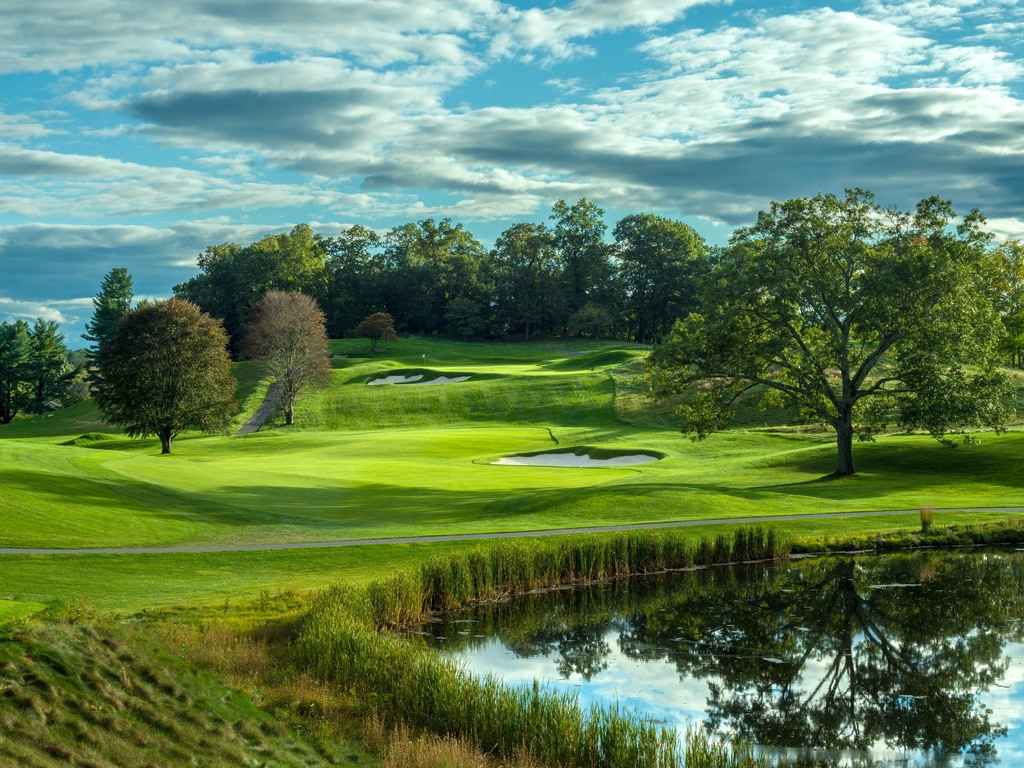
Another hole that took on drastic changes, as what Bruce found was 4 different versions of this hole on Another hole that took on drastic changes, as what Bruce found was 4 different versions of this hole on the ground. The tee sits on a rise just left of the clubhouse, hitting slightly downhill to the base of the central hill to the LZ left of the bunker. Right of the tree is the hill that had been hidden by a forest all of these years and reminds me of landform you find at Essex.
The green sits near the top of the hill, providing an approach shot to a two tiered green whose surface is hidden in a natural bowl. This was the green that Bruce did most of his work on, as the green that he found had two distinct tiers to it, with the front half so severe that it was uncuppable. A small bunker on the left protected pulled shots, but was neither in the line of play nor directly up against the green.
Bruce added a larger bunker that protected any shots that came up short on the intended line, shoved the bunker that was there closer to the green, and lifted the front half of the green to make both tiers now pinnable, creating 2x the available surface area than before.
One can’t begin to explain how much better this hole is now with these changes.
Green site and looking back down hole
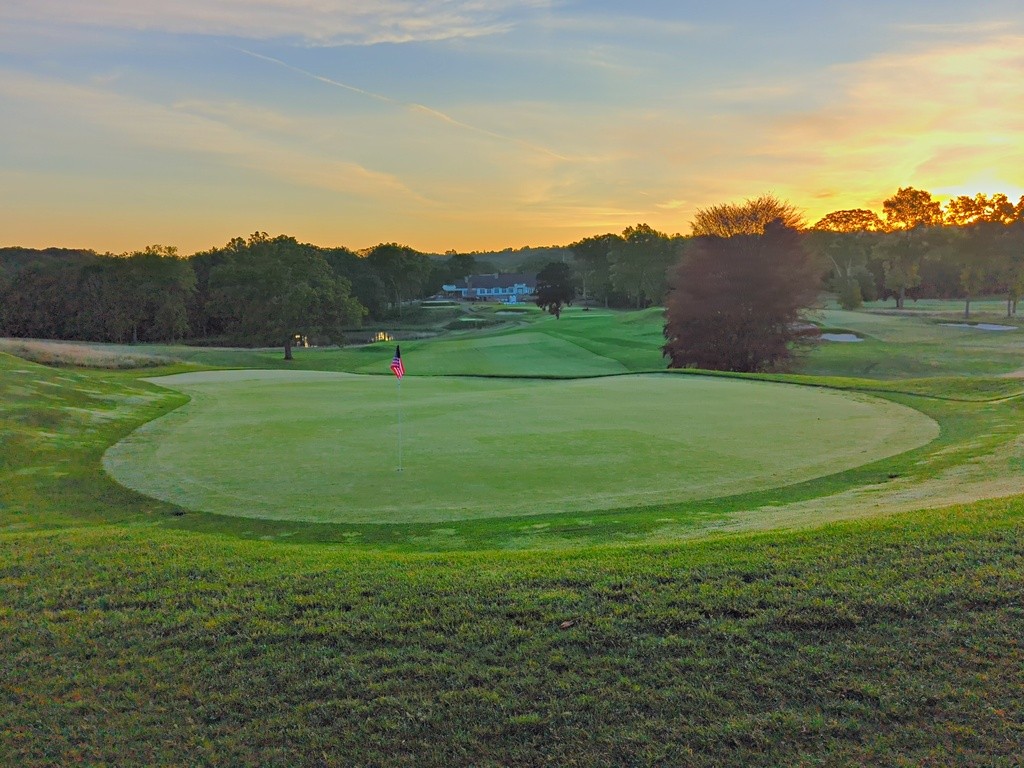
Hole 11 | Par 4
352 / 345 / 336 / 328
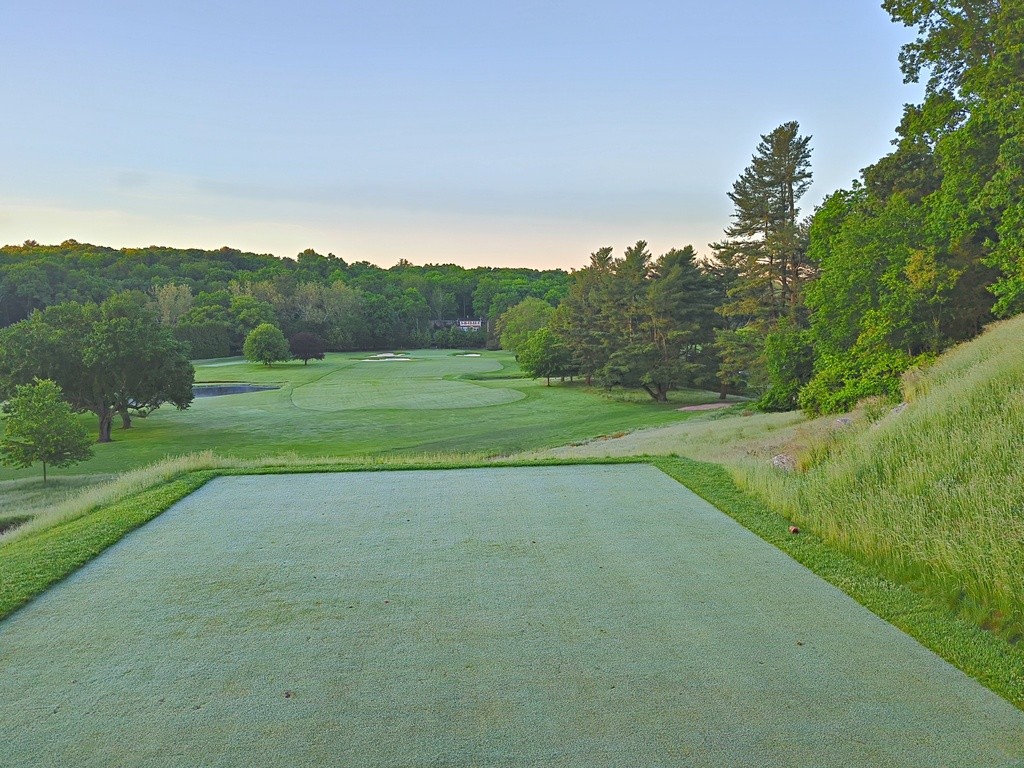
Hole 11, which was intended to be played as the 1st in WPJs routing, has been tweaked over the years as low lying areas have been more formally developed into ponds left and right of the bunker a bit over time, a tee to the right of the original tee was added to create a more dramatic tee shot in 1970s, and trees added down the fairway and around the green.
Just left of the teeing ground was the “dump,” and it's exactly what you would think - an area cluttered with all kinds of organic materials (turf, clay, stone, sand, etc.) put there from years of previous projects. Anthony and team, under guidance from Bruce, removed all of the trees and underbrush and then used the organic material to sculpt a natural looking landform back into the hill that was finished with sodded fescue. A new tee complex was added 20’ left of what was on the ground a few years ago.
The hole plays steeply downhill from the high point of the property, with fairway that is protected left and right by the two ponds, which the longer hitter can clear but many will need to consider laying up short. The preferred angle into the green is from the right, however that pond is a bit further to clear, as well as the right hand side of the hole is OB with the swim/tennis and their parking on that side of the hole.
Two greenside bunkers hug both sides of the green. Pinching in the approach to just 18 yards across. Anything long has the potential to bound to rest against a stacked stone wall just 10 paces off the back of the green just short of the property line.
This green is one of the smaller on the property, pinched in the front by the two bunkers but opened up wider as you get to the back of the green. Anything pinned in the front means you're trying to hit a green that is 10 paces across, and protected by a slight rise that I wouldn’t classify as a false front but still has the same, albeit less severe, characteristics.
Looking back up towards the tee

Hole 12 | Par 3
190 / 184 / 162 / 135
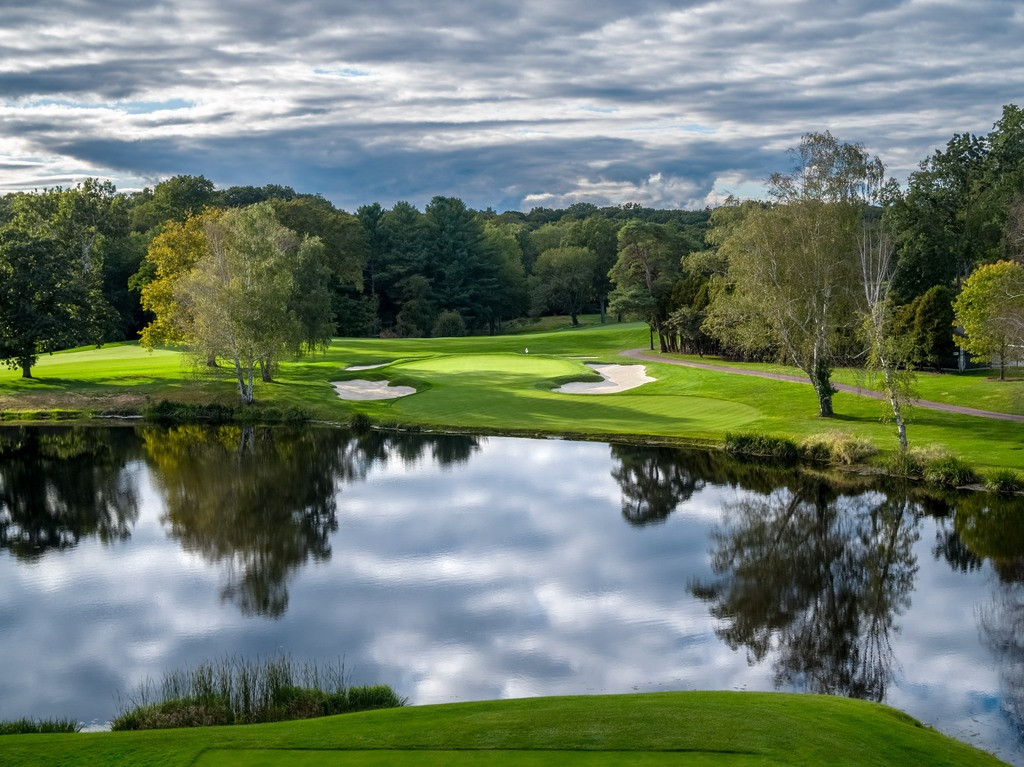
The only par 3 on that back nine, the green is original but the tee box has been moved around numerous times in conjunction with the changes to the 15th. WPJ designed this hole as playing shorter than it does today (155 yards in his routing), but now plays a bit longer with tee boxes having been moved back and right from their original spot. Bruce did close down a championship tee that was behind 15 green and back left of the current configuration.
The hole plays over the original pond used for winter activities on the property to a green site heavily protected by bunkers. The front portion of the green slightly falls of the front, with the most difficult portion of the green is the lower-mid left section, with a small little hollow created hard against the side of the green protected by the front left bunker.
From behind the green
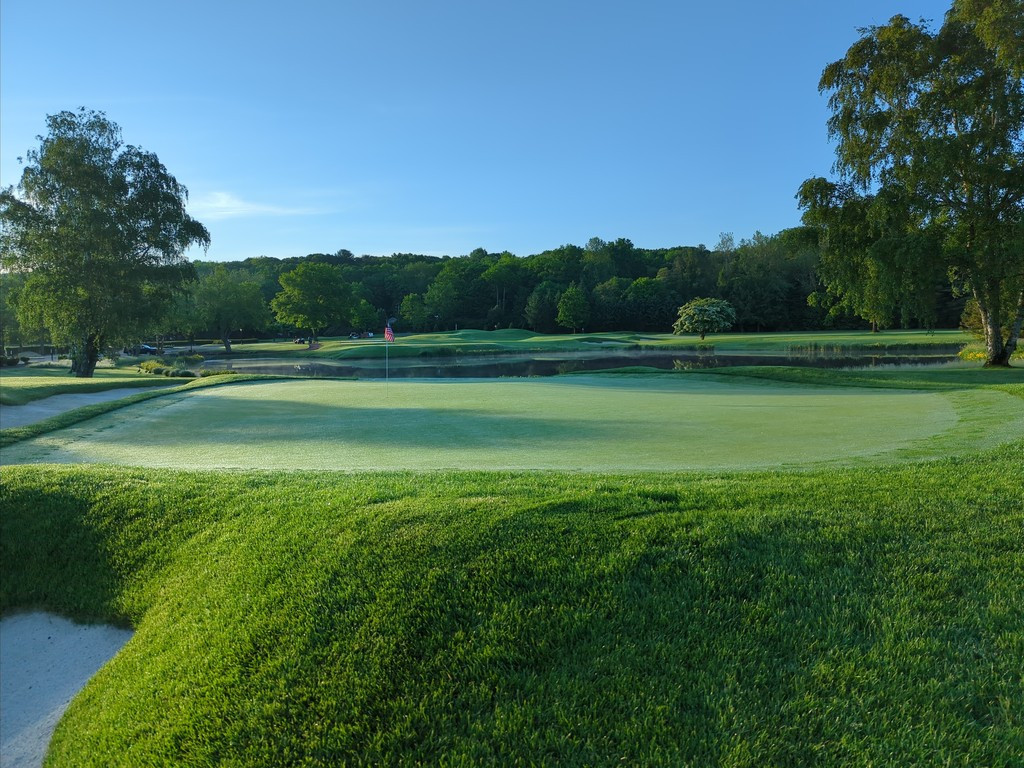
Hole 13 | Par 4
330 / 325 / 313 / 290
A really good half par 4 hole, 13 is a hole that Bruce has done a tremendous job on. Trees have been removed along the fairway, around the green and on the hillside right of the fairway as it cascades down from 6 green and 7 tee, providing for a dramatic framing, while the left hand side has been opened up with trees removed as well.
The elevated tee box plays down to a fairway that is protected by two bunkers protecting the left side for any tee shot that lays back for a better look at the elevated green. Bruce added two bunkers in the LZ on the right, really making the player think about what club to pull, and where to leave your shot.
Your approach shot, albeit mostly likely with a scoring club in hand, is anything but easy as your hitting to an elevated green and protected by a large bunker short right, as well as one left, meaning you need to be precise with your yardage.
The perched green has several tricky pin placements, none more than font right, baiting the player who goes pin seeking to hit the narrowest slide of the green to a small bump.
Evan’s shot from the 6th fairway looking back down the hole
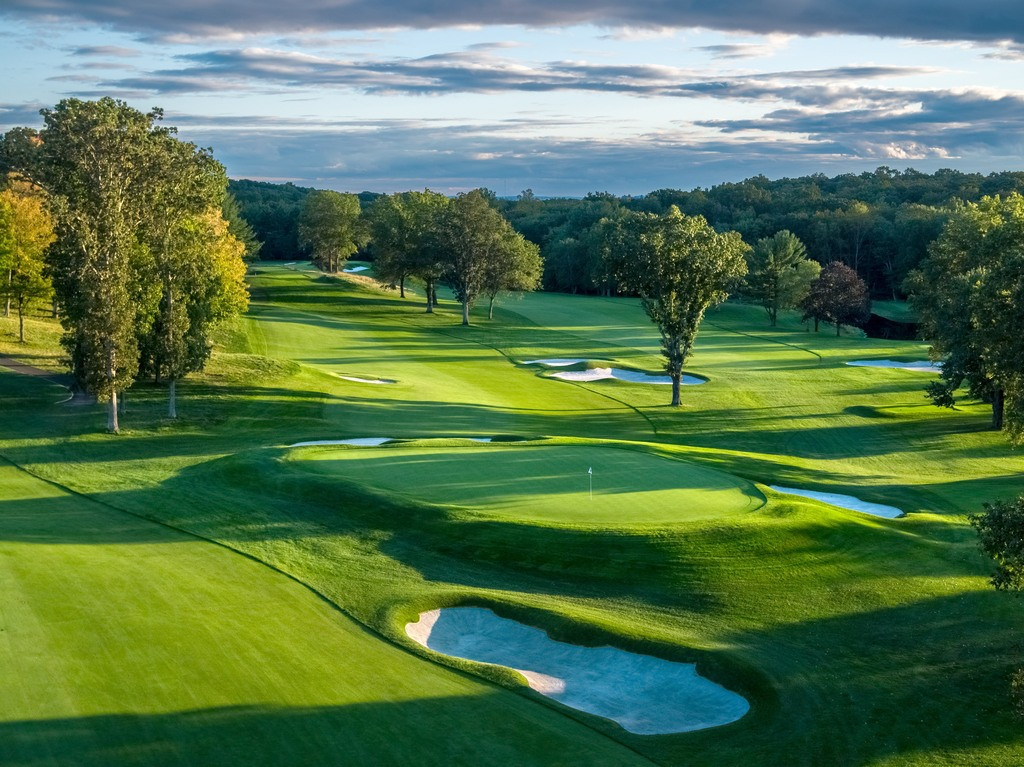
[size=78%]Hole 14 | Par 5 [/size]
603 / 573 / 555 / 479
The second and final par 5 on the course is a 3 shotter for all but a very few golfers. The tee shot is relatively straightforward off the tee with Bruce eliminating a bunker on the left side of the fairway that had been added over time
The second shot requires some thought as the hole bends slightly to the left, only to bend slightly back to the right for the green site, so you need to choose your distance wisely. WPJ visually lures you into playing the angles by advancing down the right side, however that side is fraught with danger, including a steep hill that swallows balls, or two more low lying bog areas turned into ponds in the 1960s The left side of the landing area is more open, and while the prudent play, but leaves a longer approach.
The green, again taking advantage of natural landform, sits elevated, with steep fall off on the right and back. The best movement in the green is front right and middle left, with a great hollow created between the back right with the higher edge and another WPJ bump. This was another green whose features were obscured by trees since removed, as well as a waterfall behind the green that is no longer there.
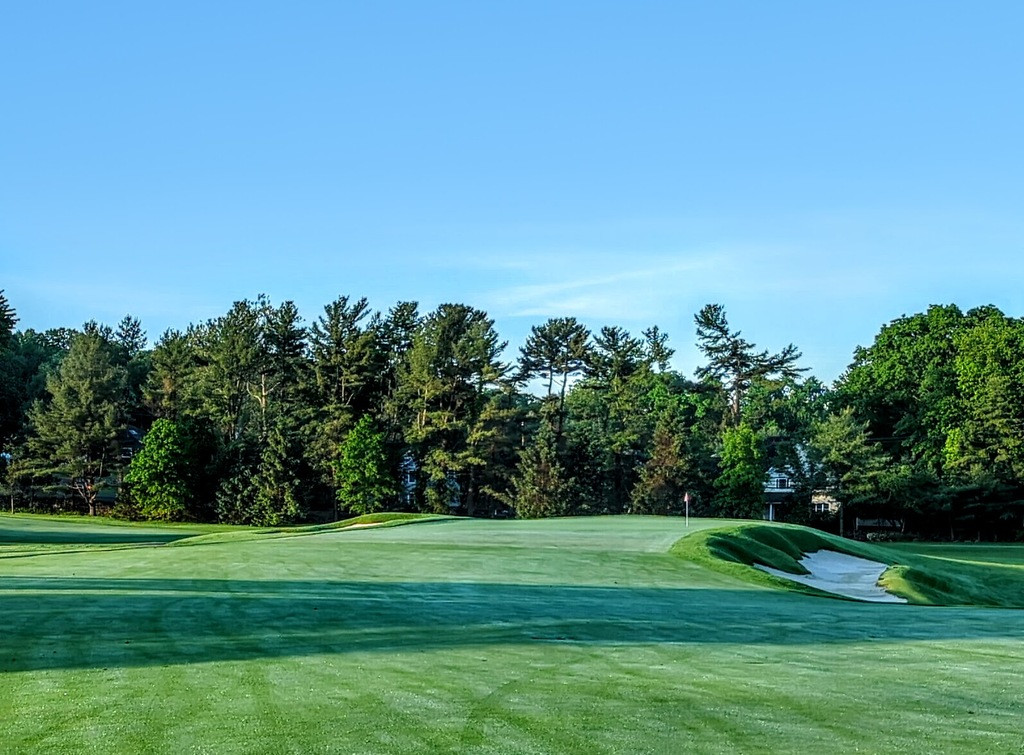
Hole 15 | Par 4
402 / 355 / 335 / 286
Of the original holes, this one has been altered the most. After abandoning the hilltop location of the WPJ clubhouse, this hole became the closing hole. First, the original green was expanded, then it was moved 40’ to 50’ to the south to extend the clubhouse terrace. It was again enlarged in 1961, when two of the long-range projects established for golf course improvement back in 1950 by architect Orrin Smith (the construction supervisor for WPJ) was finally undertaken - the improvement of the eighteenth tee and the enlargement of the eighteenth green.
Albert Zikorus, an associate of Smith in the mid-fifties who continued his practice upon Smith's retirement and subsequent death in 1958, was retained in 1961 to do the job of redesigning and renovating that green. The redesign substantially enlarged the green, provided some new contours, and completely rebuilt it's foundation. The improvement of the tee was completed by the grounds crew in 1964. Later that same year the seasonal brook a short distance across the fairway in front of that tee was piped and the ground leveled and covered with turf. Over time a new championship tee box was added, which required a lease from the town of Stamford, and has since been abandoned. Trees have been planted. And of course the two old buildings that became the first clubhouse have been demolished.
As currently laid out, the par 4 plays as a dogleg left, with the inside of the dogleg protected by trees (that still need to be thinned / removed IMO) and a bunker that attracts anyone trying to take the most direct line to the hole. The right hand side of the hole is OB and off the property, but ample room exists for all but the worst of shots. This past winter even more trees were removed along the right hand side.
Approach shots are protected by a bunker just short of the green surface and pinching in from the right, as well as greenside bunker along the right hand side of the green. Two bunkers guard the left, with an opening for those that want to run the ball onto the green. The back of this green is pushed up, falling off the back into a swale with heavy rough. The green is tilted rather significantly from back to front, with a swale running through the green from 8 oclock to 4 oclock, which means iron shots must be precise in order to have a real look at birdie and/or avoid 3 putts.
Looking back down hole, note that since this pic, trees have been removed this past winter on both the left and right
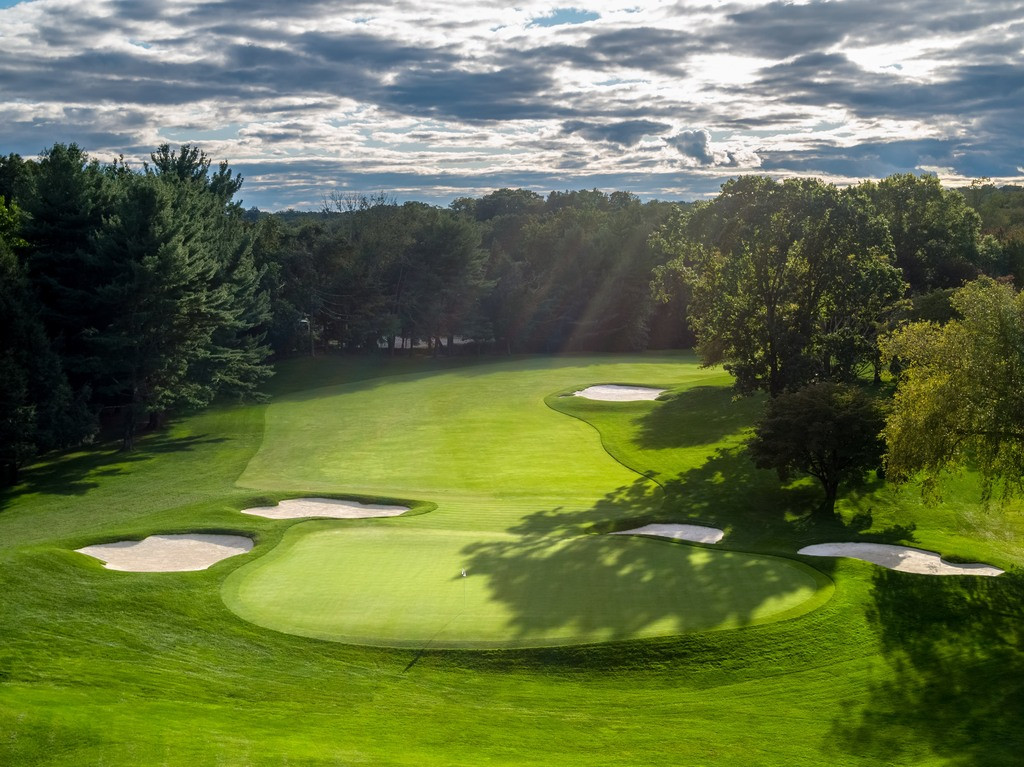
This before/after gives one an understanding of the types of changes that have occurred - changed mow line, greens extended out, bunkers moved back next to fairways, and bunkers changed back to allow the ball to run into the green.
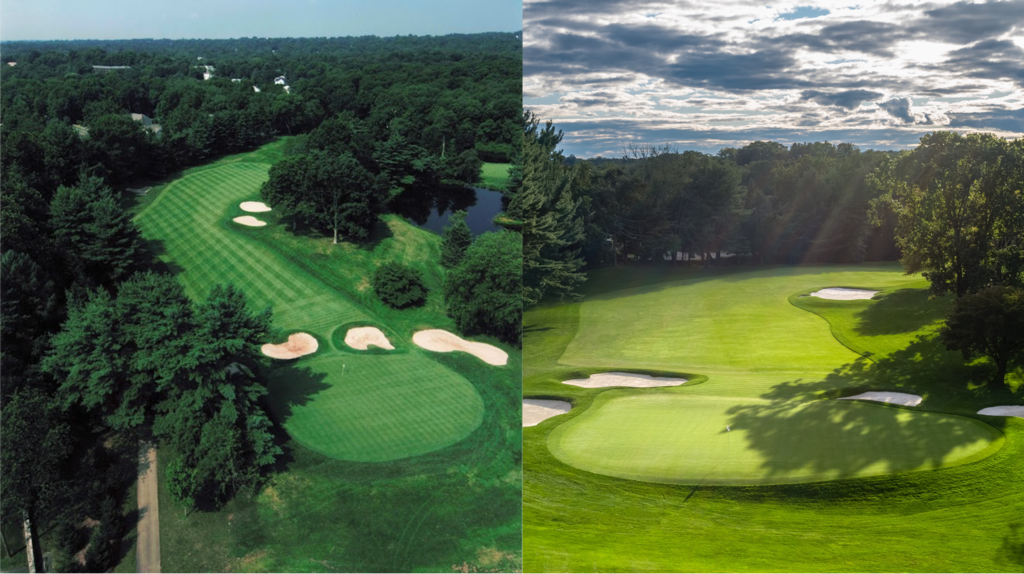
Hole 16 | Par 4
451 / 434 / 400 / 387
The 16th (1st on the routing the club opened with) is a beast of a hole, the tee shot is played over the seasonal brook, with the fairway guarded by two bunkers in the landing zones on the right and two bunkers short left what used to be the dump.
The second shot requires a precisely hit long iron to an elevated green that sits some 18 feet above the fairway. As SPDB mentioned earlier in this thread, this green used to be heavily guarded by a ring of trees as this screen grab from the course flyover shows.
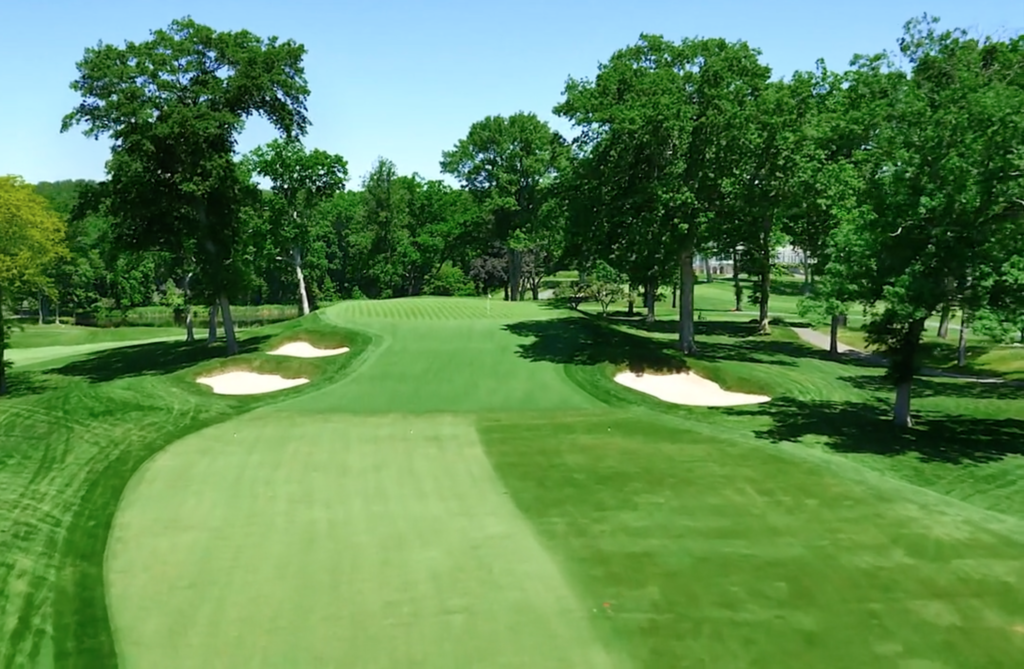
Luckily, all of the trees have thankfully been taken down, providing a spectacular setting for a surface, and of course much better conditioning.
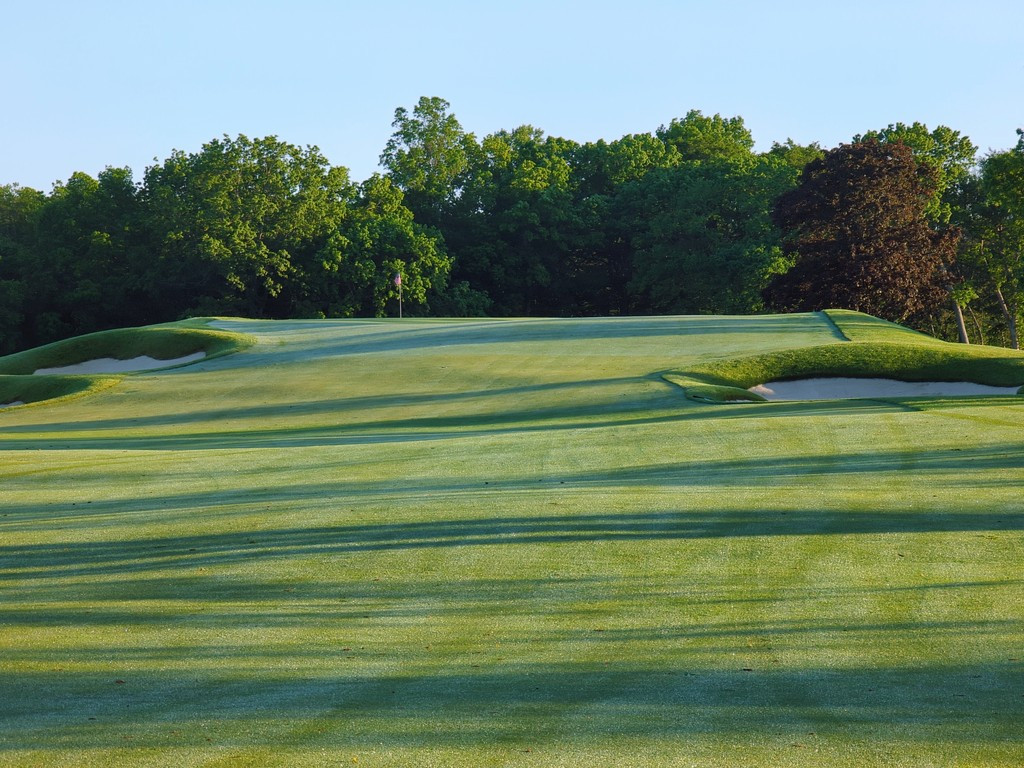
This is a green that WPJ fans will find familiar, a large surface cut into two distinct areas by a diagonally pronounced ridge running left to right across the green. Even hitting onto the correct tier doesn't mean you have it made, as each of the sections have many little humps and bumps that WPJ is known for.
Hole 17 | Par 4
356 / 350 / 335 / 305
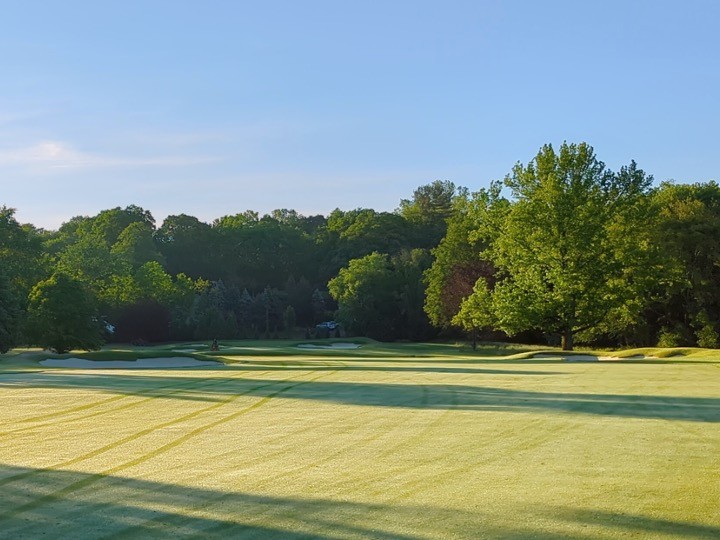
This shortish par 4 requires thought off the tee, pushing the golfer to decide both club and angle. The right hand side is more open, but leaves a longer approach and WPJ baits you into taking this angle with its wide open fairway, but it's from less than ideal angle to the smallest green on the property.
Taking the left side of the fairway provides for the best angle into the green, but brings a large bunker into play. The bunker can be carried to reach position A, but it requires a precise distance not just to carry the bunker, but also not to run out of fairway as it does run out and reach the seasonal brook that cuts across the fairway 30 yards short of the green.
As mentioned, this small green is heavily protected, with bunkers both left and right, pinching in the opening of the green and tight against the property line behind the green. This past winter two rows of pine trees were removed with new arborvitae being planted, giving you a chance for recovery for anything hit long for the first time in years. Prior to the removal, there were but a few paces over the back of the hole before the ball was in the evergreens.
Hole 18 | Par 4
381 / 371 / 345 / 318
The home hole has you crossing back over the seasonal brook that is not in play but for a topped shot. This was another hole that had a lot going on prior to the renovation, including a tee box that had been pushed to the far right of the property and all but in the wetlands that needed to be carried. Two other tee boxes that hugged the wetlands were added, and the back tee box was out of character with the entire course, and not on the same line as the other 3. Bruce eliminated all of the tee boxes and brought them all back in the line of play as they originally were positioned.
The ideal angle is from the left in order to access the meaty part of the perched and angled green, but of course this side is protected by a large bunker. Directly across the fairway and on the right hand side is a smaller, but significantly deeper bunker. Carrying the right bunker mostly likely finds a downhill lie, as the fairway falls to a small valley before rising again to an exposed green with a false front.
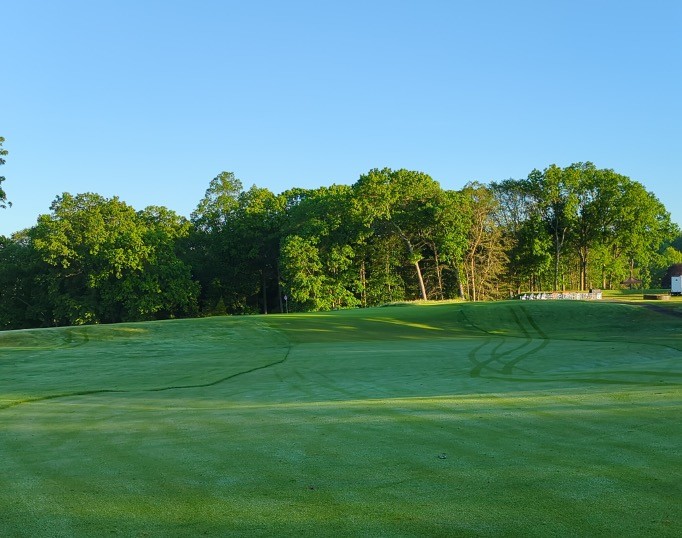
This past winter a large number of trees were removed along the right hand side, allowing enough room and airflow for Anthony to finally start cultivating the fescue.
I find this the most difficult green on the course to have a reasonable opportunity for birdie, approach shots must be hit precisely for any chance at a good look. Anything that is short feeds off the false front and back down into the valley.
Long left is a tight bunker well below the playing surface, and if you fly that you're down the hill in front of the 10th tee box with next to no chance of holding the green but for the far right side (left from this angle) of the green.
Left is the smallest part of the green, and right is the meaty part, and also the steepest part of the false front, but a long way away from anything left or middle. Past the false front, everything breaks hard left except for a small bump back right which breaks right to left. Huge trees ringing the green left and right were eliminated during the first year of the renovation.
Looking back down 18 from Evan
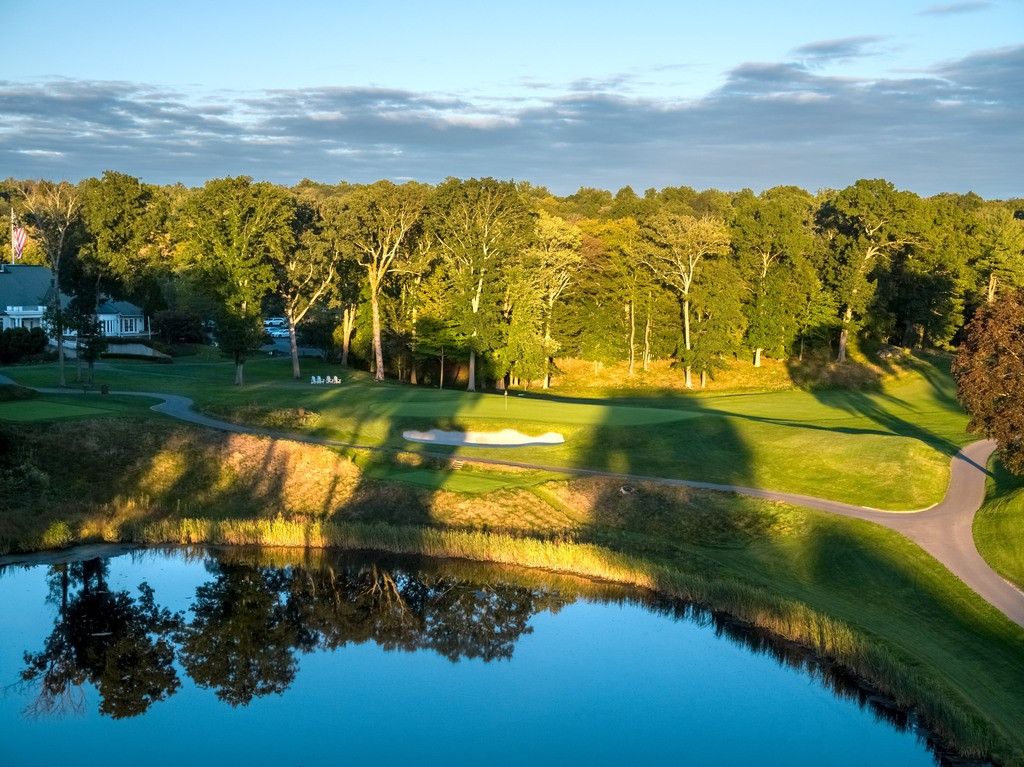
It's a REALLY good course that by the day is getting even better and I wanted to show off the work that the club is doing. I promise you the treehouse is missing out on not seeing or talking about this course, which was one of three courses Park chose to highlight on his business card, along with Sunningdale and Mount Bruno.
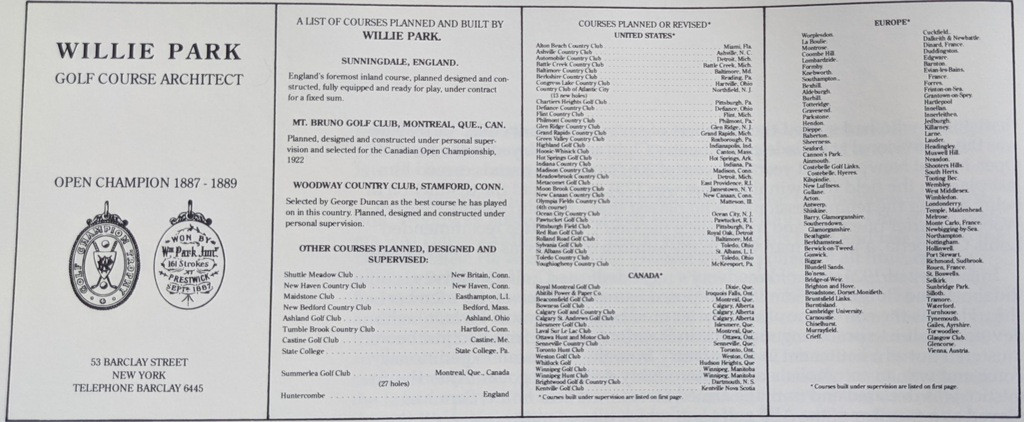
Much has been done in the past three years, with much more planned and/or contemplated, and with each new season bringing a slew of new work and changes for the better. The membership is very proud of the WPJ gem and the work that has been done to bring it back, and eternally grateful to Bruce, Anthony and a very dogged Greens and Grounds Committee. If anyone would like to see the course in person, please reach out, if I can’t host I am sure that I could get someone to show you around.